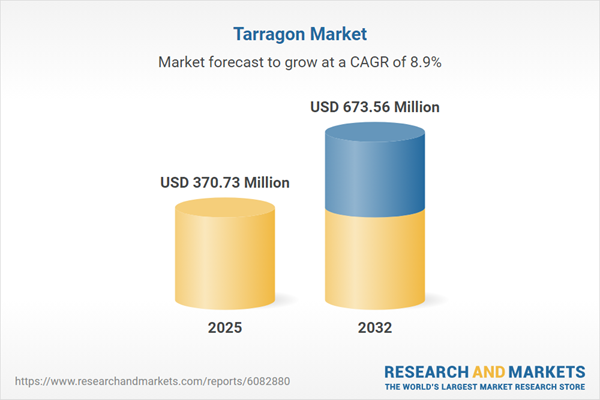Speak directly to the analyst to clarify any post sales queries you may have.
The Tarragon Market is experiencing significant transformation, shaped by changing regulatory environments, innovation in cultivation, and evolving uses in the botanical ingredient sector. Senior decision-makers are positioned to leverage these shifts for strategic advantage amid a changing global botanical landscape.
Market Snapshot: Tarragon Market Size and Growth Insights
The Tarragon Market expanded from USD 340.65 million in 2024 to USD 370.73 million in 2025, with long-term projections indicating compound annual growth at 8.89% and a market value of USD 673.56 million by 2032. These dynamics reflect both robust demand and growing investments from established players and new entrants. The market environment is marked by innovation in both inputs and outputs, increased adoption of value-added tarragon products, and diverse regional opportunities as applications extend beyond legacy culinary sectors.
Tarragon Market Scope & Segmentation
This research offers senior leaders a granular view of the Tarragon Market, highlighting critical segments and influential factors for business planning, risk assessment, and targeted growth initiatives:
- Form: Dried, extract, and fresh tarragon each bring distinct advantages, supporting various flavor profiles, potency levels, and shelf-life needs throughout food, beverage, and ingredient sourcing workflows.
- Farming Methods: Conventional and organic cultivation practices enable providers to align with sustainability goals and respond to evolving regulatory standards.
- Distribution Channels: Direct marketing, online retail, specialty stores, and supermarkets/hypermarkets remain pivotal for accessing diverse consumer and business segments, supporting both direct and mass-market strategies.
- End User: Food service, household, and industrial sectors utilize tarragon for culinary, ingredient, and manufacturing purposes, with broad-based demand for clean-label and functional botanical products.
- Regional Coverage: The Americas (including North and Latin America), Europe, Middle East & Africa, and Asia-Pacific regions exhibit differentiated strategies influenced by local market preferences, logistical considerations, regulatory frameworks, and partnership opportunities.
- Company Analysis: Leading organizations such as McCormick & Company, Cargill, Olam International, International Flavors & Fragrances, Givaudan, Symrise, Kerry Group, Döhler, and Archer-Daniels-Midland are reviewed to highlight unique innovation pipelines and their strategic positioning in the tarragon value chain.
Key Takeaways for Senior Decision-Makers
- New applications, especially in clean-label and plant-derived product categories, are driving market expansion beyond traditional culinary uses.
- Intensifying regulations and sustainability goals have led to widespread adoption of organic certifications and enhanced traceability, fostering transparency throughout the value chain.
- Technological advances, such as improved extraction techniques and vertical farming, are enabling greater consistency and driving higher quality across supply chains.
- Enhanced supply chain models, including e-commerce and direct sales, grant both established and emerging players the ability to serve niche consumer bases and achieve scalability.
- Collaboration and partnerships help businesses adapt more quickly to regulatory shifts and changing consumer demands by expanding their resource base from farm through distribution.
Tariff Impact: US Policy Developments and Market Response
Recent United States tariff measures introduced in 2025 have triggered realignment of sourcing and procurement models within the Tarragon Market. Importers are diversifying sourcing regions and seeking tariff-free options to maintain competitiveness, while domestic producers are investing in advanced, climate-resilient cultivation. Companies are also implementing near-shoring strategies and engaging in collaborative procurement to reduce exposure to policy-driven risks, supporting ongoing supply chain continuity and resilience.
Methodology & Data Sources
This report integrates primary interviews with key stakeholders—including agronomists, processors, and distributors—cross-validated by secondary sources such as industry publications, regulatory data, and proprietary ingredient databases. Additional insights are drawn from GIS mapping and targeted case studies to ensure comprehensive, actionable findings.
Why This Tarragon Market Report Matters
- Access detailed segmentation and regional insights to inform capital allocation, market entry decisions, and new product strategies.
- Benefit from guidance on building resilient sourcing frameworks, adapting to policy updates, and utilizing technology to achieve competitive differentiation.
Conclusion
The Tarragon Market’s growth story emphasizes the importance of innovation, flexible sourcing, and regulatory alignment. Data-driven decision-making and active collaboration are essential for sustained success in this evolving sector.
Table of Contents
3. Executive Summary
4. Market Overview
7. Cumulative Impact of Artificial Intelligence 2025
Companies Mentioned
The companies profiled in this Tarragon market report include:- McCormick & Company, Incorporated
- Cargill, Incorporated
- Olam International Limited
- International Flavors & Fragrances, Inc.
- Givaudan SA
- Symrise AG
- Kerry Group plc
- Döhler GmbH
- Archer-Daniels-Midland Company
Table Information
| Report Attribute | Details |
|---|---|
| No. of Pages | 191 |
| Published | October 2025 |
| Forecast Period | 2025 - 2032 |
| Estimated Market Value ( USD | $ 370.73 Million |
| Forecasted Market Value ( USD | $ 673.56 Million |
| Compound Annual Growth Rate | 8.8% |
| Regions Covered | Global |
| No. of Companies Mentioned | 10 |









